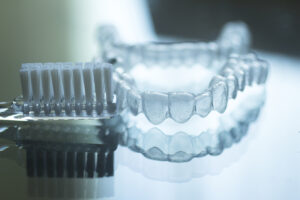Unlocking the Secret of Invisalign: A Comprehensive Guide to How It Works

Invisalign has revolutionized the way people achieve straight, beautiful smiles without traditional metal braces. This modern orthodontic treatment uses clear, removable aligners to gradually move teeth into their desired positions. Invisalign offers a convenient, discreet, and comfortable option for both teens and adults looking to improve their smiles. But how does Invisalign work exactly?
What is Invisalign?
Invisalign is a cutting-edge orthodontic treatment designed to straighten teeth using a series of clear, removable aligners. Unlike traditional braces, which use metal brackets and wires, Invisalign aligners are made from a smooth, BPA-free plastic that is virtually invisible when worn. This makes them a popular choice for both teens and adults who want to improve their smile discreetly.
Invisalign was first introduced in 1997 by Align Technology, and since then, it has transformed the orthodontic industry. The system uses advanced 3D imaging technology to create a custom treatment plan for each patient. This technology allows orthodontists to map out the entire treatment process from start to finish, ensuring precise and predictable results.
The Invisalign Process
How does Invisalign work? Getting started with Invisalign involves a few key steps to ensure a successful treatment journey.
1. Initial Consultation
The first step in the Invisalign process is scheduling a consultation with an experienced orthodontist. During this appointment, the orthodontist will evaluate your teeth and discuss your goals for treatment. They will determine if Invisalign is the right option for you based on your specific dental needs.
2. Custom Treatment Plan
Once you decide to proceed with Invisalign, the orthodontist will create a personalized treatment plan. This involves taking digital scans or impressions of your teeth, which are then used to develop a 3D model of your mouth. Using this model, the orthodontist will design a series of aligners that will gradually move your teeth into the desired position. You’ll also receive an estimated timeline for your treatment, so you know what to expect along the way.
3. Creation of Aligners
After your treatment plan is finalized, the custom aligners are manufactured using state-of-the-art 3D printing technology. Each aligner is made from a patented thermoplastic material that is designed for both comfort and effectiveness. You will receive a series of aligners, each slightly different from the last, to be worn in sequence.
Throughout the treatment, you will typically switch to a new set of aligners every one to two weeks. Each set is specifically calibrated to make slight adjustments to the position of your teeth. Regular check-ups with your orthodontist will ensure that your treatment is progressing as planned and that any necessary adjustments can be made.
How Does Invisalign Work?
Invisalign is designed to gradually and effectively straighten teeth through a carefully planned series of aligners. Each aligner plays a crucial role in the treatment process, ensuring that teeth move into their ideal positions over time.
1. Mechanics of Movement
How does Invisalign work? The core of Invisalign’s effectiveness lies in the mechanics of teeth movement. Each aligner is engineered to apply controlled force to specific teeth. These forces are gentle yet precise, guiding teeth into their new positions incrementally. The aligners are designed to target different parts of the teeth at various stages, ensuring a comprehensive and even alignment.
The aligners themselves are made from a proprietary thermoplastic material that is both flexible and strong. This material ensures that the aligners fit snugly over your teeth, applying consistent pressure without causing significant discomfort.
2. Wearing the Aligners
For Invisalign to be effective, wearing the aligners as directed by your orthodontist is crucial. Typically, aligners should be worn for 20 to 22 hours per day. They should only be removed for eating, drinking anything other than water, brushing, and flossing. Consistent wear ensures that the teeth are constantly under the pressure needed for movement.
Adjusting to wearing the aligners might take a few days. Initially, you might feel some pressure or discomfort, which is a sign that the aligners are working. However, this usually subsides as your teeth begin to move.
3. Switching Aligners
The process of moving to the next set of aligners is straightforward but essential for continuous progress. You will switch to a new set of aligners every one to two weeks, as advised by your orthodontist. Each new aligner is slightly different from the previous one, designed to take your teeth another step closer to their final positions.
Regular appointments with your orthodontist are part of the Invisalign process. These check-ups are typically scheduled every 6 to 8 weeks. During these visits, your orthodontist will monitor your progress, make necessary adjustments, and provide you with the next sets of aligners.
Switching aligners on schedule is critical. Delaying this can slow down your treatment, while advancing too quickly can cause discomfort and potential complications. Following the orthodontist’s guidance ensures a smooth and efficient treatment process.
4. Monitoring Progress
Throughout the Invisalign treatment, monitoring progress is essential. Your orthodontist will track how your teeth are moving and make any necessary changes to the treatment plan. They may provide additional aligners or refine the current ones to ensure optimal results.
In some cases, small, tooth-colored attachments may be applied to your teeth to help the aligners grip better and direct forces more precisely. These attachments are temporary and are removed once they are no longer needed.
Benefits of Invisalign
Invisalign offers a range of benefits that make it a popular choice for those seeking orthodontic treatment. From aesthetic advantages to practical benefits and health improvements, Invisalign provides a comprehensive solution for achieving a beautiful, straight smile.
1. Aesthetic Advantages
One of the most appealing aspects of Invisalign is its nearly invisible appearance. The clear aligners are difficult to detect when worn, allowing you to straighten your teeth discreetly. This is particularly advantageous for adults and teens who may feel self-conscious about wearing traditional metal braces.
Invisalign aligners are custom-made to fit snugly over your teeth, ensuring a natural look and feel. This means you can smile, speak, and socialize with confidence throughout your treatment.
2. Practical Benefits
Invisalign aligners are designed for convenience and ease of use. They are removable, allowing you to take them out for meals and special occasions. This means you can enjoy your favorite foods without worrying about damaging your orthodontic appliance, something that can be a concern with traditional braces.
The removable nature of Invisalign also makes it easier to maintain good oral hygiene. You can brush and floss your teeth as usual, reducing the risk of plaque buildup, cavities, and gum disease during treatment.
Additionally, Invisalign typically requires fewer visits to the orthodontist compared to traditional braces. With no wires to tighten or brackets to adjust, your check-ups are generally quicker and less frequent.
3. Health Benefits
Invisalign not only enhances the appearance of your smile but also contributes to better oral health. Properly aligned teeth are easier to clean, reducing the risk of cavities and gum disease. Misaligned teeth can create hard-to-reach areas where food particles and plaque accumulate, leading to dental problems over time.
Furthermore, correcting bite issues with Invisalign can alleviate stress on the jaw, reduce wear and tear on teeth, and even improve chewing and speech. Addressing these issues can prevent more serious dental and health problems in the future.
Invisalign Maintenance and Care
Proper maintenance and care of your Invisalign aligners are crucial to ensure the effectiveness of your treatment and the health of your teeth. Here’s how you can take good care of your aligners and maintain optimal oral hygiene throughout your Invisalign journey.
1. Cleaning the Aligners
Keeping your aligners clean is essential to prevent staining and buildup of bacteria. Here are some tips for cleaning your aligners:
- Daily Cleaning Routine: Rinse your aligners every time you remove them. Use a soft toothbrush and clear, unscented antibacterial soap to gently brush your aligners. Avoid using toothpaste, as it can be abrasive and scratch the clear plastic.
- Recommended Cleaning Products: Consider using Invisalign cleaning crystals or special cleaning solutions designed for aligners. These products can help remove plaque and keep your aligners clear and fresh.
2. Oral Hygiene Tips
Maintaining good oral hygiene is even more important when wearing Invisalign aligners. Here’s how you can keep your teeth and gums healthy:
- Brushing and Flossing: Brush your teeth after every meal before putting your aligners back in. This prevents food particles from getting trapped between your teeth and the aligners. Don’t forget to floss daily to remove debris from between your teeth.
- Avoiding Stains: Remove your aligners before consuming any food or drink other than water. Foods and beverages can stain the aligners, making them more noticeable. Rinse your mouth and aligners after eating or drinking anything that could stain.
3. Troubleshooting Common Issues
During your Invisalign treatment, you might encounter some common issues. Here’s how to address them:
- Discomfort and Soreness: It’s normal to experience some discomfort or soreness when you start wearing a new set of aligners. This usually subsides within a few days as your teeth adjust. If the pain persists, consult your orthodontist.
- Lost or Damaged Aligners: If you lose or damage an aligner, contact your orthodontist immediately. They might advise you to move on to the next set of aligners or go back to the previous set until a replacement is available. It’s crucial to follow their instructions to avoid disrupting your treatment.
- Keeping Track of Aligners: Always store your aligners in their protective case when not in use. This prevents them from getting lost or damaged and ensures they stay clean.
Trust Pacific Northwest Orthodontics for Your Invisalign Needs
At Pacific Northwest Orthodontics, led by Dr. Bobby Virk and Dr. Basma Tamasas, we create beautiful smiles in a fun and friendly environment. Located in Tacoma, WA, our practice has been providing gentle, patient-focused care since 1994. We take pride in building long-term relationships with our patients, treating them as friends, and making their orthodontic journey enjoyable.
Dr. Virk’s 30 years of experience and Dr. Tamasas’s advanced training ensure you receive top-quality care with the latest technology. We strive to make your experience with Invisalign not only effective but also the best part of your day.





